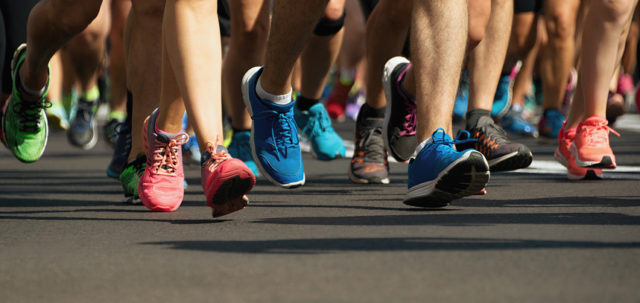Happy June Challengers!
During this quarter, we’re introducing a new element to work towards our #BestPerformance. We started with a self-assessment, we’ve learned about running with the FLOW (aka running in color), and our current focus is on #GoodForm. At the end of this month, we will celebrate our mastery of these concepts with our second Virtual Race of the year: The 4th of July Victory Lap Run!
As we build on our recent focus on strides and head-to-toe form drills, next up, we’re evaluating our running cadence for #goodform and our #sleep habits for our #BestPerformance.
Keep reading to find:
- How to Find and Optimize Your Cadence
- Sleep for your Best Performance
- May Challenger of the Month
- Podcast: The Egoscue Method for Postural Therapy
- The Challenge 2018 Store
- Facebook Group Etiquette
Post your progress with #BestPerformance, #GoodForm, #Sleep, the Workout of the Season (#WOS), and any of your other training adventures in our private Facebook group for a chance to earn some high fives, support, and win a gift certificate to the Challenge Store!

#GoodForm: How to Identify and Optimize Your Cadence
Running cadence is the number of strides (or steps) you take in a minute. Knowing your running cadence is a little like knowing the tire pressure on your car—keeping the number in an optimal range will help with efficiency.
What is the optimal running cadence?
According to legendary running coach Jack Daniels, the general rule of thumb for efficient running is 90 strides per minute for one foot (180 for both), however, there is variance based on leg length and speed. When walking, your cadence is lower, speed walking a little faster, jogging faster yet, and running it increases again. Cadence is a product of speed and your personal biomechanics.
An average cadence that is at least 170 will reduce the impact forces on your legs, improve your efficiency and momentum, and reduce your risk of injuries.
How to Find and Track Your Cadence
Some runners find that a 170ish cadence feels good for easy effort runs, while 180 is optimal for faster effort runs. If you don’t already know your cadence, you can easily find your cadence by counting the number of strides (steps) on one foot for one minute and doubling the number.
You can also use a training app like Pro Metronome or some running devices give you the cadence as you run. The app and device provide a way to review your cadence data post run and continue to improve it.
How to Optimize Your Cadence
An effective way to increase your cadence is to do so in small bits so your body has a chance to adapt to the new movement pattern and you can find your optimal range along the way.
For instance, if you are at 168 strides per minute (or 84 strides on one foot), set your app to 170-172 strides (86-88) and run to the app cadence during your runs. The key is to take it slowly and focus on keeping your strides shorter. If you increase your cadence and maintain a longer stride, your heart rate and effort will increase as well. When increasing cadence, focus on keeping your stride landing under your hips and with short, efficient strides.
Another fun way to weave in cadence work is to run 4-6 striders after your warm up and before your run. Instead of focusing on lengthening your stride and speed as we learned last month, the focus is on increasing stride frequency and getting into a comfortable rhythm with a higher cadence.
Performing this drill during your warmup will aid in neuromuscular re-patterning and retrain the brain to first feel the difference (jogging in place with quick feet) and then change the inefficient pathways into more efficient ones on the run.
Another fun way to optimize cadence is to listen to a song or music mix that is at your target cadence. Simply match your cadence with the beats per minute and simple run to the beat. There are lots of apps that allow you to choose your cadence and run to beat.
Practice Patience
Like all new skills, dialing in your cadence will take time to learn. However, the investment of time and patience will have a profound effect on your energy management and running efficiency down the road.

#Sleep: A #BestPerformance Healthy Habit
Our best performance rests firmly quality sleep. It allows our body to recover from the demands of training and life and restores energy to run another day.
Research indicates that getting a quality night’s sleep is not only beneficial for health, it can also boost your performance. According to the National Sleep Foundation, we average about six hours and 40 minutes per night, which is well short of the recommended 7-9 hours.
Some of the benefits of good quality sleep include recovery and restoration physically and mentally, muscle growth stimulation, and bone building. Conversely, inadequate sleep can lead to cardiovascular issues, poor athletic performance, hypertension, weight gain due to elevated cortisol levels, and put you at risk factor for insulin resistance and Type 2 diabetes.
Over the next two weeks, start to invest in #Sleep by using one of the following sleeping habits, or creating one of your own.
- Make sleep a priority and commit to getting at least 8 hours of sleep every night.
- Develop a sleep routine and aim to go to bed and wake up at the same time every day, even on weekends.
- Develop a sleep ritual you follow every night to unwind and prepare to go to sleep (reading, meditation or focused breathing, drinking calming herbal tea, journaling, warm bath.)
- Create a sleeping zone. Make your bedroom a sleep only space and remove electronics, food, and work.
- Evaluate your bedroom. Keep the temperature cool (60-67F) free from noise, and comfortable mattress and pillows.
- Turn the lights down (or off) and shut down electronics (phone, tablets, computer) 2-3 hours prior to going to bed. The blue light emitted from electronics has been shown to suppress melatonin production.
- Nurture your natural circadian rhythms by exposing yourself to bright light in the morning and avoiding it in the evening.
- Log it. Think of sleep as an important part of your life training plan and keep track of it in your log. Write down the number of hours you slept, how you feel when you wake up if it was restless or you woke up in the night.
- Use a device like the Fitbit to track your sleep performance and note the hours, the times you were awake or restless and how you felt.
- Avoid caffeine, alcohol and heavy meals in the evening.
Remember, this isn’t about all or nothing. It’s all about making one small #Sleep habit, hitting the repeat button, and paying attention to how it feels along the way. Post your progress or your sleep tips in the group using the hashtag #Sleep!
Listen to Coach Jenny’s podcast on how to improve sleep performance and her personal journey through sleep deprivation.

Challenger of the Month
Big congratulations to Cathy Kirkland Garner, our Challenger of the Month for May!
Cathy started off the month not feeling great, but bounced back and has been consistently working on #GoodForm and reaching her personal goals by getting her miles in, some yoga, and some pretty great #SweatySelfies!
Cathy has chosen the St. Jude Children’s Research Hospital in Memphis, TN for the donation we will make in her name. Check them out here:
WANT TO BE OUR CHALLENGER OF THE MONTH? Use the hastags#GoodForm and/or #BestPerformance in your posts for the month of June to be considered!


